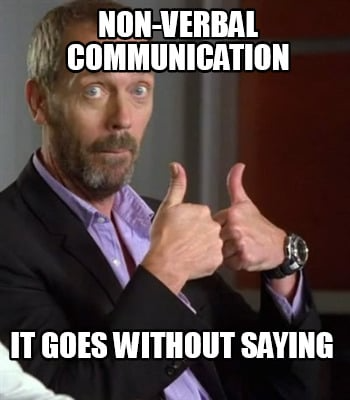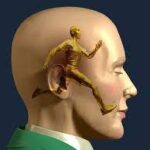
Hi All,
Let’s talk non-verbal communication! What are the myths, how do investigators detect lies, and what are examples from the working world?
Enjoy!
Non-Verbal Communication: Investigating Body Language & Facial Expressions

Depending on the source it is suggested that language is around 35,000 to 40,000 years (max. 100,000 years) old. In contrast, humans (i.e., homo sapiens) exist for ~300,000 years, meaning that the majority of the time we communicated non-verbally. Non-verbal communication (NVC) is deeply rooted in us as a species and we are highly receptive to it.
A lot of us have probably heard the idea that ‘if someone looks up to the right or is rubbing their nose, they are most likely lying’. But is that true? According to multiple studies (linked below), no significant correlation has been found to support this statement. The idea came out of the Neuro-linguistic programming space but has never been proven scientifically.
While we are at debunking myths:
Is it true that 93% of information is communicated non-verbally?
In short: No. When we look into how the initial study (which makes this claim) was constructed, we see that the information communicated verbally vs. non-verbally was heavily incongruent. For example: If someone says ‘I love you’ but looks at the person in disgust, most people (I hope) would see this as a reason to doubt the spoken word. However, in real life, verbal and non-verbal communication is mostly a lot more aligned and deviations are more subtle. Yes, NVC is important but scientists argue that in reality, it accounts for much less than 93%.
Now that we have cleaned that up,
What is it that we should be paying attention to?
Business psychologist Dirk Eilert is a leading expert in the field of facial expressions, body language, and emotional intelligence. Among other consultancy areas, he trains police officers to better read their counterparts in interrogations.
Eilert stresses that if we want to understand if someone communicates authentically, first, we need to get an understanding of the person’s baseline behaviour. What is their normal way of communicating (e.g., tone of voice, degree of gestures, posture, or level of eye contact)? We need to have a certain feel for the other person.
Secondly, we need to pay attention to deviations from this behaviour. For example, if someone is asked to describe what happened, recalling a memory is less cognitively demanding compared to constructing a new story, which takes up significant mental capacity. Heightened cognitive demand can cause stress, which is often used to indicate if someone is telling the truth (*). If a task requires significant mental capacity, it can also lead to unaligned verbal and non-verbal communication as gestures might show up delayed or not in sync. For example, if people are asked to say the ABC out loud and make gestures with each letter, this usually flows easily and appears congruent. However, if the task is to say the ABC out backward and make gestures with each letter, people tend to think first, then make the gesture afterward as their mental capacity is already fully taken up by the first step.
Thirdly, it is important to pay attention to the bigger picture i.e., other causes of altered behaviour. For example, anxiety can greatly impact the way someone communicates non-verbally; it can make a person freeze (e.g., interfere with gesticulation), change their tone of voice and facial expressions. While the above is helpful to understand communication better, it is important to be conscious of outside criteria.
(*) Polygraphs (often referred to as lie detector tests) are created to measure exactly that – a person’s stress response based on physiological measures like change in heart rate, blood pressure, respiratory rate, and sweat. A change in baseline rates can indicate that the person is attempting to be deceptive.
Why can Facial expressions be so revealing?
Facial expressions can either be driven consciously by our motor skills, or subconsciously by our limbic system. The limbic system is a collection of structures in our brain involved in emotional processing of inputs from the sensory systems. If a perceived stimulus is subconsciously processed by the limbic system, information travels faster than 500 milliseconds and can move our faces before we recognise it. (Unless Botox is involved 🙂 )
Before we move into the working world, I want to let you know that you can support my work on Ko-fi: Ko-fi.com/neurosciencemusings. If you choose to do to: THANK YOU!!
Now,
What if you pitch your ideas to someone and they cross their arms?
According to Eilert the crossing of arms does not signal rejection but seclusion. The difference here is that the person crossing their arms isn’t necessarily against what is presented but needs secluded space to e.g., process more deeply what is being said (away from distractions e.g., outside noise). Research has shown that people tend to cross their arms when thinking deeply and studies have found that participants remained longer on a difficult task when their arms were crossed. Former FBI agent Joe Navarro even calls arm-crossing a “self-soothing” gesture, meant to comfort oneself rather than to “block” others.
So, next time we present to someone and they cross their arms we may feel pleased with their engagement, rather than worried about wrongly perceived rejection.
As highlighted above, we should always take the bigger picture into account: if a room is cold, people are more likely to cross their arms. The same tends to happen when a person sits on a chair without armrests, in which case the movement is likely driven by the seeking of comfort.
Does video conferencing hinder effective communication?
While there are a lot of benefits to Zoom calls in terms of flexibility, it does not meet the in-person experience. What do we miss out on when speaking on video calls?
- We can’t make eye contact, which is an important NVC tool. (We either look at the screen to see the other persons facial expressions, or into the camera to mimic eye contact but in this case, we will miss to read the face of the other person.)
- Communication isn’t clearly directed anymore. E.g., in group conference calls we cannot address another person by moving our head and attention towards them.
- If a person is presenting to a larger group, individuals tend to feel less observed or addressed, which can lead to reduced engaged behaviour. Also, for the person presenting it can be difficult to tell if a listener looks upset because they disagree or because their child is banging on the door for the fifth time.
- Reduced social feedback loop! Humas are wired for connection and rely on social feedback to understand their effect in the world. If we stick with the ‘presenting to a large group on Zoom’ example, it can amplify the stress responses in the presenter if they don’t receive encouraging feedback like nodding, smiling, or engaged facial expressions.
Some of you might be familiar with the Still Face experiment run in the 1970s, where mothers were asked to keep a straight face when looking at their babies and to not respond for 2min. This caused so much distress in the babies that they cried and partly started to hurt themselves e.g., by biting their hand. Their central nervous system became so overwhelmed by the threat of disconnect that they physically collapsed.
We probably will not start crying however, a lack of social feedback does cause stress.
[Side note: this is also why people tend to be uncomfortable with silence. At a primal level, the uncertainty of silence/lack of social feedback can lead people to panic.]
Before we wrap up, a quick look onto the globe:
Is NVC culturally universal?
To answer this question, we will break down components of NVC as the answers differ:
| NVC considered culturally universal: | NVC considered culturally dependent: |
|
|
To Conclude: Every BODY Says Something
I will leave you with the words from Dirk Eilert: The knowledge around non-verbal communication should not be used to try and rip down another person’s mask, but to deepen connection by better understand each other.
For thoughts and questions, reach me on instagram @neuroscience.musings or the contact form on here.
Have a great day!!
Best regards,
Sarah
Resources:
- Wiseman, R., Watt, C., ten Brinke, L., Porter, S., Couper, S. L., & Rankin, C. (2012). The eyes don’t have it: Lie detection and neuro-linguistic programming. PloS one, 7(7), e40259.
- Mann, S., Vrij, A., Nasholm, E. et al. The Direction of Deception: Neuro-Linguistic Programming as a Lie Detection Tool. J Police Crim Psych 27, 160–166 (2012). https://doi.org/10.1007/s11896-011-9097-8
- Mehrabian, A. (1968). Some referents and measures of nonverbal behavior. Behavior Research Methods & Instrumentation, 1(6), 203-207.
- Weinberg, M. K., Beeghly, M., Olson, K. L., & Tronick, E. (2008). A Still-face Paradigm for Young Children: 2� Year-olds’ Reactions to Maternal Unavailability during the Still-face. The journal of developmental processes, 3(1), 4–22
- Roxo, M. R., Franceschini, P. R., Zubaran, C., Kleber, F. D., & Sander, J. W. (2011). The limbic system conception and its historical evolution. TheScientificWorldJOURNAL, 11, 2427-2440.
- Davis, K. D., Pope, G. E., Crawley, A. P., & Mikulis, D. J. (2004). Perceptual illusion of “paradoxical heat” engages the insular cortex. Journal of neurophysiology, 92(2), 1248-1251.
- Parkinson, C., Walker, T. T., Memmi, S., & Wheatley, T. (2017). Emotions are understood from biological motion across remote cultures. Emotion, 17(3), 459-477. http://dx.doi.org/10.1037/emo0000194
- https://www.forbes.com/sites/carolkinseygoman/2021/08/18/how-to-read-body-language-on-zoom/?sh=3820b5b5234c
- https://www.forbes.com/sites/nickhobson/2017/12/11/3-nonverbal-behaviors-from-others-that-signal-they-like-you/?sh=2dfc09a73a1b
- https://www.verywellmind.com/types-of-nonverbal-communication-2795397
- https://www.rd.com/list/science-facts-never-learned/
- https://www.jnforensics.com/post/9-truths-exposing-a-myth-about-body-language
- https://www.gov.uk/government/publications/domestic-abuse-bill-2020-factsheets/mandatory-polygraph-tests-factsheet
- https://deutschepodcasts.de/podcast/so-bin-ich-eben/was-verrat-unsere-mimik-mit-dirk-eilert


